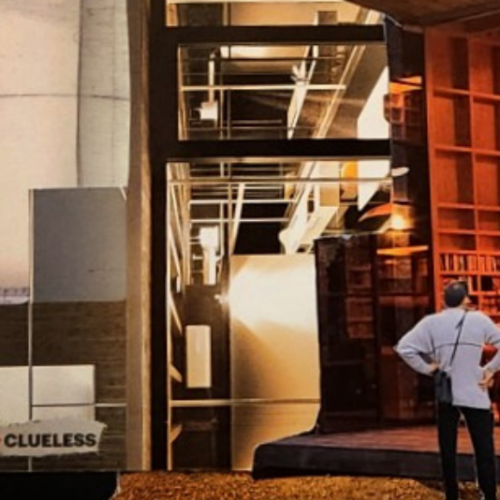Repetitiously
A dream that I dream repeatedly: The Minnesota Department of Transportation (MnDOT) stops building the I-35W Bridge. Instead of a crossing that straddles the open air above the Mississippi, MnDOT builds a tunnel under the river. As is the way of dreams, the distortion of reality plays out like this: because the road travels underground, deep beneath the river’s waterway, the road rises to an exaggerated height. Because the vehicles are only partially self-propelled, they build momentum by dropping from these heights to slingshot through the underground crossing. In a sleeping fugue, I ride in the car up an ascent, then helplessly plummet, and the feeling in my body, the terror of that fall, whimpers me awake.
In a manner of speaking
For the seasons: fall back, spring forward.
Fall in: Ten-hut!
Into another’s outstretched arms: the trust fall.
For a mate: Patsy Cline, “I fall to pieces.”
Spiritually: to fall to your knees.
Transcendentally: into a different fate.
Historically
When you are little, you play “hot lava” on the backyard swing set. You spider-shimmy over the parallel bars and monkey swing from the rungs. Pretend the cool grass burns fire-hot. Keep moving! Avoid touching the ground with any body part. If you fall, you lose.
As an adult, an image comes to you, unbidden. Pompeii. Two humans lying on their sides, embracing. The lava approaches. The mountain brews. How quickly did civilization fall? You sometimes think gory thoughts. Did they perish from smoke inhalation or from the rising lava crackling at their feet? Where did you first see this image? Maybe National Geographic. Or was it the nature shows you’d watch with Mom, both of you on the king-sized bed atop the blue flowered bedspread? Or were you watching alone in the tenebrous light of the basement, spine pressed against the jut of the coffee table, knees pulled to your chest? One corpse had been female, the other a child. You still wonder about them sometimes.
In a knowing way
To slip on ice or tumble onto concrete. Falling down stairs. Falling on one’s tailbone. When we were small, we fell and skinned our knees. Jessica McClure fell down a well.
As a girl, my mom raised a pet squirrel that fell out of a tree. She would tell me this story repetitively, but I didn’t mind. I enjoyed the levity on her face when she told me about her strict parents allowing her to raise a squirrel—in the house! My favorite part of the story was when she explained how the creature, named Joey, like an Australian kangaroo, would swing from Grandma’s floor-to-ceiling draperies.
Jeannette Walls wrote in Half Broke Horses, “The most important thing in life is learning how to fall.” A friend’s boyfriend told her, “If you’re not falling, you’re not growing.” I once ran the diagonal of a floor exercise mat: round off, back handspring, back flip. During lift-off into the flip, I lost focus and fell. Wham! Landed on my back and shoulders, bounced up, and walked off the blunder like I was only embarrassed. My gymnastics coach told me, “I don’t mind if you fall, but fall differently.” Don’t keep repeating the same mistake.
Viscerally
As a babe, she slumbered on her mother’s chest. Tha-thump. Tha-thump. The heartbeat of her protector. Skin against skin, she lay in the curve of her mama’s side, tiny arms tucked in. She understood touch, the rigid clavicle beneath her cheek. She understood the heartbeat’s ambient noise amplified by her ear pressed plumb against the body. She understood rhythm, the way a swimmer hears sound above the surface. All muscles limp, power deadened, she felt the tha-thump before she fell from her mother’s arms into the arms of another mother. When babies lose their original mothers, there’s no other way but to fall.
Crying Whee! all the way down
Some say the dropping sensation felt on a roller coaster can approximate orgasm. Some people love to fall. Bungee jumpers leap from bridges and spring back on flexible bands. Skydivers plummet earthbound, undaunted, saved by a firm tug on the ripcord. Zip liners. Cliff divers. Base jumpers wear special suits simulating a bird’s wings and fall intentionally, leaping off thousand-foot cliffs.
Indelible in my memory is an elementary-aged visit to an amusement park called Valleyfair. We boarded the Flume, a combination roller coaster water ride culminating in a saturating splash. The log car caught on the hill’s chain and lifted us high. At the teetering apex, I ducked under the front of the car, squeezed my eyes shut, and screamed. At the bottom, we abruptly leveled out, and I hit my head on the car’s inside roof. All my classmates were dripping wet, but I was dry as desert sand.
As a consequence of engineering failure
One fall leads to another. We fall and fall and fall. We roll over, we compose ourselves, we leap up or slowly rise, whatever it takes, we get up. Until we don’t.
Fracture-critical Federal Bridge 9340, the old I-35W Bridge in Minneapolis, Minnesota, USA, fell in thirteen seconds on August 1, 2007. I fell. Nearly one hundred eighty others fell too. On the anniversary, I sometimes take to social media to record a tribute to the dead. Once, I wrote about making memory tactile. I count the 13 names on my hands, in alphabetical order, bending a finger for each life: Artemio, Christina, Greg, Hana, Julia, Patrick, Paul, Peter, Richard, Sadiya, Scott, Sherry, Vera.
In spring 2019, CNN reported that at our current pace, it will take 80 years to repair all of America’s structurally deficient bridges. After I-35W fell, the collective voices all said, “Never again,” yet bridges still fall: the Harp Road Bridge in Oakville, Washington—August 15, 2007; the Cedar Rapids and Iowa City Railway bridge in Cedar Rapids, Iowa—June 12, 2008; the San Francisco–Oakland Bay Bridge—October 27, 2009; the Eggner Ferry Bridge over the Tennessee River in Kentucky—January 27, 2012; Jay Cooke State Park Swinging Bridge in Carlton, Minnesota—June 20, 2012; the I-5 Skagit River Bridge in Mount Vernon, Washington—May 23, 2013; the Florida International University Pedestrian Bridge—March 15, 2018. There are more.
This will happen again, and if it happens in your hometown, you could fall. Or if you don’t fall, you could know someone who does. Your friend, sister, brother, cousin could be on the bridge. Or your coworker’s wife. Or your neighbor’s sister. Or the kids on your child’s preschool bus.
Once something pivotal falls, you start to notice the frequency of falling. You hate the feeling in your belly during a fall. You want to know if your aversion can be ameliorated with knowledge. So you watch Nova, “Trapped in an Elevator,” hoping that understanding your fears can allay them. Fascinating: At a 28-story test site in Connecticut for Otis Elevator, elevators freefall daily and technicians refine safety brakes. Loaded with 12,000 pounds of lead—the max load rating—they stop in less than four feet with a force of 1g or less. One G-force equals the force of gravity at the Earth’s surface. Watching the show helps. Despite your hatred of falling, elevators are arguably the safest mode of transportation (by statistical measurements).
In spite of falling
In the lead-up to the tenth anniversary of the I-35W Bridge fall, on August 1, 2017, my wife, Rachel, wants to go to a restaurant and bar called Betty Dangers, whose popular draw is its outdoor Ferris wheel. We’ve ridden it before and enjoyed it, so I agree. Traffic detours and parking is a challenge. We’re stressed when we arrive but we plan to have fun, so we persist. Michael Jackson’s “Wanna Be Startin’ Somethin’” tinges the air with festival flair.
We board and, waiting for the ride to start, I realize suddenly that I don’t want to be on it. Everything in my body screams, NO NO NO NO. We’re going to swing, it’s gonna go high, oh god oh god, I don’t want…
My L5 disc (injured when I fell on the bridge) starts throbbing, burning—unusually so—and the speed of this post-traumatic stress trigger hits me intensely. When this occurs, the body is the command center. My intentions, my desire to “think positive,” are not in charge. Neither are my plans to be unaffected when a tremoring buzz electrifies. My eyes flood behind my blue mirrored sunglasses.
“Are you okay?” Rach asks after the Ferris wheel completes a revolution. She wants to hold my hand, but I rapidly shake my head no. I tell her I’m going to push through it.
Later, on Facebook, a fellow collapse survivor will comment, “I have blocked out a lot of the accident, but have avoided fair rides ever since the collapse, as I fear a certain movement or drop will bring it all back. I loved rides prior, and now my fear of it all coming back keeps me from it.”
We ask to exit the ride early. The upside, I tell Rach, is the tears keep my contacts wetted, and my sister’s recommendation for waterproof eyeliner and mascara is paying off big time. Ten years after the collapse, I deny the grief, but here it is, unpredicted.
I tell Rach, “I’m sorry I have PTSD.”
“It’s okay,” she says.
I say, “That was the worst ride ever.”
We laugh. It’s not the first or the last PTSD episode, but grounded as we are, striving for perspective, we know the worst damage was borne by those who never went home. We slide into the car, then ride the on-ramp onto a high-speed four-lane highway.
“My back hurts.” I don’t usually say this. It doesn’t always hurt enough for me to announce it. I don’t have to pretend with Rach.
She says, “Ohhh,” sounding supportive and wifely.
I say, “The PTSD is never going away.”
Then Rach says something that hits me in the solar plexus, the way that only someone who’s known and loved you through the excitement and drudgery of marriage, through the mess of trauma and ongoing attempts at recovery, can ever know. She says, “That’s ’cause it’s your battle scar, baby.”
In acceptance
“Is the meeting in a high-rise?” I ask my sister, Shelley. She confirms. I say okay with a tone I hope sounds like Sure, no big deal. May 2019. We’re at a family appointment in downtown Saint Paul. Although avoiding the elevator ride is impractical, technically I could climb thirty flights of stairs. I decide to deal should my body slip into a post-traumatic stress episode. I think to myself, Just another small challenge; you can get through this. I dread the ride, but I don’t voice this. Until I do.
I tell Shelley, “I’ve kind of been dreading this since I saw the room number was W3070, knowing the first two digits usually indicate the floor.” We approach the elevator bays, press the up arrow button, and I’m consoling myself with thoughts of Expect the dropping and it’ll be done in a flash.
As the doors close, my sister presses the floor thirty button and reaches for my hand. We don’t typically hold hands. On the inside, I’m so moved by this small act. I feel my sister’s firm grip. Strong from all those years gripping uneven parallel bars in gymnastics, strong because we are family. The ride has begun, and the chatting in the elevator is a welcome distraction. Astonishingly, the ascent feels steady.
August 1, 2019 will be the twelfth anniversary of the bridge collapse. This is the first time I’ve not dealt with PTSD (while awake) in a high-rise elevator.
After the meeting, having successfully ridden the elevator back to the ground without a PTSD reaction, I stand on the sidewalk with Shelley. Rachel works nearby and will pick me up.
“You don’t have to wait with me,” I tell Shelley. “She’ll be here any minute.”
“No, I want to,” she says.
A few more minutes pass. Again, I say she doesn’t have to wait. She’s resolute in staying.
“There are sketchy people around here,” she says. Sketchy. This is Shell’s word for homeless people.
“I’m fine.” Looking down the street for Rach, I repeat that she’ll be here any minute.
“No, I’ll wait with you,” she says, and then a second later adds, “There are people with mental illness.”
My thoughts tilt, but my sister’s homeless-phobia pales against her good qualities, plus the surge of affection I feel for her and my confidence upon conquering the high-rise elevator has me in good spirits.
Amused, I say, “You know, I have a mental illness.”
Later, I will think back on this ride. I will think back on Shelley taking my hand. I will think about how precious the feeling of hope can be. There will be other falls. This I’ve learned to count on. During our brief lifetimes, we will ride roller coasters, Ferris wheels, and elevators we don’t want to ride. There will be other PTSD triggers, and the bad ones will come, and I may cry or be debilitated, but this is my life’s Pompeii. To accept that we fall: fall and fall and fall.

Kimberly J. Brown
Kimberly J. Brownwas a Minnesota Book Award finalist for her book, THE I-35W BRIDGE COLLAPSE: A SURVIVOR’S ACCOUNT OF AMERICA’S CRUMBLING INFRASTRUCTURE (Potomac Books, 2018). Her writing has appeared in The Under Review,Puerto Del Sol,Queer Voices: Poetry, Prose, Pride!,Sleet Magazine, amongst others. She’s been a Minnesota State Arts Board grantee and a winner of a Loft Literary Center mentorship. She holds an MFA from Hamline University.



